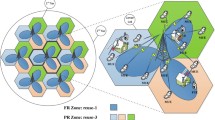Abstract
Orthogonal frequency division multiple access (OFDMA) is extensively utilized for the downlink of cellular systems such as long term evolution (LTE) and LTE advanced. In OFDMA cellular networks, orthogonal resource blocks can be used within each cell. However, the available resources are rare and so those resources have to be reused by adjacent cells in order to achieve high spectral efficiency. This leads to inter-cell interference (ICI). Thus, ICI coordination among neighboring cells is very important for the performance improvement of cellular systems. Fractional frequency reuse (FFR) has been widely adopted as an effective solution that improves the throughput performance of cell edge users. However, FFR does not account for the varying nature of the channel. Moreover, it exaggerates in caring about the cell edge users at the price of cell inner users. Therefore, effective frequency reuse approaches that consider the weak points of FFR should be considered. In this paper, we present an adaptive self-organizing frequency reuse approach that is based on dividing every cell into two regions, namely, cell-inner and cell-outer regions; and minimizing the total interference encountered by all users in every region. Unlike the traditional FFR schemes, the proposed approach adjusts itself to the varying nature of the wireless channel. Furthermore, we derive the optimal value of the inner radius at which the total throughput of the inner users of the home cell is as close as possible to the total throughput of its outer users. Simulation results show that the proposed adaptive approach has better total throughput of both home cell and all 19 cells than the counterparts of strict FFR, even when all cells are fully loaded, where other algorithms in the literature failed to outperform strict FFR. The improved throughput means that higher spectral efficiency can be achieved; i.e., the spectrum, which is the most precious resource in wireless communication, can be utilized efficiently. In addition, the proposed algorithm can provide significant power saving, that can reach 50% compared to strict FFR, while not penalizing the throughput performance.







Similar content being viewed by others
Notes
\(\lceil x \rceil\) is the ceiling function of x which is the smallest integer greater than or equal to x
References
Negishi, M. (2003). Development of mobile phone culture in Japan and its implications to library services: prospecting information services in coming ubiquitous society. NII Journal, 56.
Ahmadi, S. (2013). LTE-advanced: A practical systems approach to understanding 3GPP LTE releases 10 and 11 radio access technologies. London: Academic Press.
Jeffrey, A. G., Buzzi, S., Choi, W., Hanly, S. V., Lozano, A., Soong, A. C. K., et al. (2014). What will 5G be? IEEE Journal on Selected Areas in Communications, 32(6), 1065–1082.
Berardinelli, G., Pajukoski, K., Lahetkangas, E., Wichman, R., Tirkkonen, O., & Mogensen, P. (2014). On the potential of OFDM enhancements as 5G waveforms. In The proceedings of 79th IEEE Vehicular Technology Conference (VTC Spring), pp. 1–5.
Onoe, S. (2016). Evolution of 5G mobile technology toward 2020 and beyond. In The proceedings of IEEE International Solid-State Circuits Conference (ISSCC), pp. 23–28.
Hamza, A. S., Khalifa, S. S., Hamza, H. S., & Elsayed, K. (2013). A survey on inter-cell interference coordination techniques in OFDMA-based cellular networks. IEEE Communications Surveys & Tutorials, 15(4), 1642–1670.
Assaad, M. (2008). Optimal fractional frequency reuse (FFR) in multicellular OFDMA system. In The proceedings of 68th IEEE Vehicular Technology Conference (VTC Fall), pp. 1–5.
Novlan, T., Andrews, J. G., Sohn, I., Ganti, R. K., & Ghosh, A. (2010). Comparison of fractional frequency reuse approaches in the OFDMA cellular downlink. In The proceedings of IEEE Global Telecommunications Conference (GLOBECOM), pp. 1–5.
Hassan, N. U., & Assaad, M. (2009). Optimal fractional frequency reuse (FFR) and resource allocation in multiuser OFDMA system. In The proceedings of International Conference on Information and Communication Technologies (ICICT), IEEE, pp. 89–92.
Chang, R. Y., Tao, Z., Zhang, J., & Kuo, C. C. J. (2009). A graph approach to dynamic fractional frequency reuse (FFR) in multi-cell OFDMA networks. In The proceedings of IEEE international conference on communications (ICC 2009), pp. 1–6.
Chang, R. Y., Tao, Z., Zhang, J., & Kuo, C. C. J. (2013). Dynamic fractional frequency reuse (D-FFR) for multicell OFDMA networks using a graph framework. Wireless Communications and Mobile Computing, 13(1), 12–27.
Aliu, O. G., Mehta, M., Imran, M. A., Karandikar, A., & Evans, B. (2014). A new cellular-automata-based fractional frequency reuse scheme. IEEE Transactions on Vehicular Technology, 64(4), 1535–1547.
Shao, H., Jing, W., Wen, X., Lu, Z., Zhang, H., Chen, Y., et al. (2016). Joint optimization of quality of experience and power consumption in OFDMA multicell networks. IEEE Communications Letters, 20(2), 380–383.
Zhang, H., Nie, Y., Cheng, J., Leung, V. C. M., & Nallanathan, A. (2017). Sensing time optimization and power control for energy efficient cognitive small cell with imperfect hybrid spectrum sensing. IEEE Transactions on Wireless Communications, 16(2), 730–743.
Zhang, H., Jiang, C., Mao, X., & Nallanathan, A. (2014). Resource management in cognitive opportunistic access femtocells with imperfect spectrum sensing. In The proceedings of IEEE Global Telecommunications Conference (GLOBECOM), pp. 3098–3102.
Zhang, H., Jiang, C., Mao, X., & Chen, H. (2016). Interference-limited resource optimization in cognitive femtocells with fairness and imperfect spectrum sensing. IEEE Transactions on Vehicular Technology, 65(3), 1761–1771.
Zarrinkoub, H. (2014). Understanding LTE with MATLAB: from mathematical modeling to simulation and prototyping. London: Wiley.
http://www.gyokovsolutions.com/manuals/gnettrack_manual.php, [last visited 28-03-2017].
Tse, D., & Viswanath, P. (2005). Fundamentals of wireless communication. Cambridge: Cambridge University Press.
I. WP5D. (2008). Guidelines for evaluation of radio interface technologies for IMT-advanced. Document 5D/TEMP/99-E, Tech. Rep.
Author information
Authors and Affiliations
Corresponding author
Rights and permissions
About this article
Cite this article
Elwekeil, M., Alghoniemy, M., Muta, O. et al. Performance evaluation of an adaptive self-organizing frequency reuse approach for OFDMA downlink. Wireless Netw 25, 507–519 (2019). https://doi.org/10.1007/s11276-017-1571-5
Published:
Issue Date:
DOI: https://doi.org/10.1007/s11276-017-1571-5




